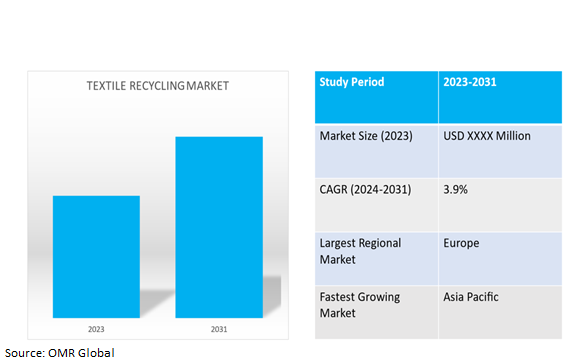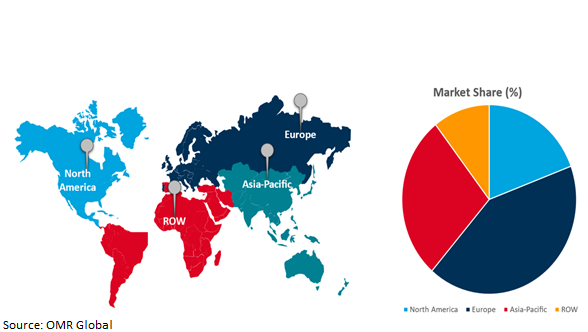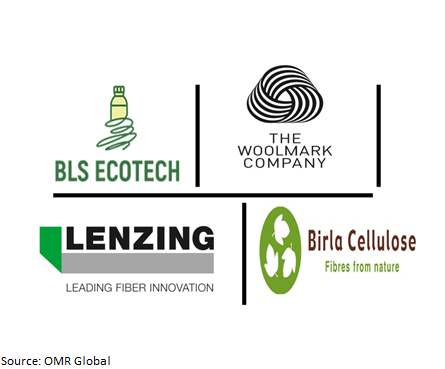Textile Recycling Market
Textile Recycling Market Size, Share & Trends Analysis Report By Material (Cotton, Polyester, Wool, Polyamide and Nylon), By Textile Waste (Pre-consumer and Post-consumer), By Process (Mechanical, Chemical, By End-User (Automotive Waste, Retail Waste, Mining Waste, Building & Construction Waste, Apparel Waste, Home Furnishings Waste, and Industrial Waste) Forecast Period (2024-2031)
Textile recycling market is anticipated to grow at a moderate CAGR of 3.9% during the forecast period (2024-2031). Textile recycling involves reusing or repurposing textile materials to prevent them from ending up in landfills, contributing to waste reduction and environmental conservation. Textiles encompass a wide range of materials, including clothing, bedding, towels, curtains, and other fabric-based items. The global textile recycling market is driven by increasing awareness and concern for environmental sustainability.

Market Dynamics
Growing collaboration offers an attractive opportunity for market growth
The growing collaboration among the key market players is expected to offer an attractive opportunity to global textile recycling market growth over the forecast period. For instance, in April 2023, A new women's capsule collection produced of recycled fabrics derived from polycotton textile waste was released by the Spanish retail apparel giant Zara in partnership with Circ, a fashion technology company that recycles textile waste back into new fibers.Eleven markets can buy the set. To create new recycled raw materials for apparel, Zara and Circ have disassembled polycotton, a textile made of both polyester and cotton.
Circ's recycling technology can separate polycotton mixed textile waste and recover both cellulosic and synthetic fibers, according to a joint press release from Zara and Circ. The line also includes polyester clothes manufactured with 43.0% recycled polycotton textile waste and lyocell apparel made with 50.0% recycled polycotton textile waste. Under the creative direction of the Zara Woman design team, the collection consists of trendy, airy burgundy apparel that is designed to be worn frequently. Thus, this kind of initiative offers an attractive opportunity for market revenue growth.
Government Initiatives and Regulations to Drive the growth of the market
Government initiatives and regulations aimed at promoting sustainable practices and reducing textile waste to promote the growth of the textile recycling market. Many countries are implementing policies to address the environmental impact of the textile industry, including setting targets for recycling rates and promoting circular economy principles.For instance, the European Union’s Circular Economy Action Plan targets a 55.0% recycling rate for plastic packaging and 30.0% for textiles by 2030. The alignment of the textile recycling industry with such regulatory frameworks creates opportunities for businesses to participate in and benefit from government-supported sustainability initiatives.
Market Segmentation
Our in-depth analysis of the global textile recycling market includes the following segments by material, textile waste, process and by end-user:
- Based on material, the market is sub-segmented into cotton, polyester, wool, polyamide and nylon.
- Based on textile waste, the market is bifurcated into pre-consumer and post-consumer.
- Based on process, the market is augmented into mechanical and chemical.
- Based on end-user, automotive, retail, mining, building & construction, apparel, home furnishings and industrial waste.
Polyester is Projected to Emerge as the Largest Segment
Polyester is the most widely manufactured polymer it is preferred in manufacturing apparel as it is heat sensitive, highly-stain resistant, and easy to clean. Due to rising demand from the apparel sector the usage of recycled polyester in clothes is increased. Polyester is expected to grow at the fastest CAGR during the forecast period. Polyester is a synthetic fiber with increasing popularity due to its durability and affordability. Growing concerns about environmental impact and the push for recycled polyester contributes to its rapid growth in textile recycling. Compared to virgin polyester, recycled polyester has a smaller carbon impact, according to the Sustainable Apparel Coalition's Higg Material Sustainability Index. Moreover, each kilogram of mechanically recycled polyester results in a reduction of approximately 70.0% of greenhouse gas emissions.
Apparel Waste Sub-segment to Hold a Considerable Market Share
The apparel waste segment is expected to hold a considerable market share over the forecast period. It includes trash made from fabric left over after production, damaged or rejected clothing, and post-consumer waste like left shoes and clothing, among other things. The typical lifespan of a new item of clothing has drastically reduced over the last two decades, increasing the amount of trash produced by the clothes industry. The aforementioned elements are anticipated to fuel demand for clothing material recycling.
Regional Outlook
The global textile recycling market is further segmented based on geography including North America (the US, and Canada), Europe (UK, Italy, Spain, Germany, France, and the Rest of Europe), Asia-Pacific (India, China, Japan, South Korea, and Rest of Asia), and the Rest of the World (the Middle East & Africa, and Latin America).
Asia-Pacific is anticipated to exhibit the highest CAGR in the textile recycling market. The demand for textile recycling activities is anticipated to increase in this region over the forecast period owing to rising concerns regarding the environmental impact of textile waste, increasing government initiatives for textile waste management, and ongoing development of innovative technologies for textile recycling.
Global Textile Recycling Market Growth by Region 2024-2031

Europe Holds Major Market Share
Europe is expected to hold the largest global textile recycling market share over the forecast period. The growth in the region is attributed to the rising public support from national governments and an increase in recycling-related projects. The Trash and Resources Action Program (WRAP), which was founded in the UK and is active throughout Europe with the assistance of regional administrations and private businesses, encourages the recycling of trash, including textile waste. In Europe; Germany, Italy, France, Belgium, the Czech Republic, and Poland are the biggest market for recycled apparel. Italy is a well-known hub for the recycling of textiles and is the capital of textile recycling.
Over a hundred companies have joined the Italian Textile and Recycling Association, located in Prato, Italy, where traditionally, old rugs and clothes are collected from all over the world and converted into yarn.Europeannations tend to have a higher standard of living and spend more money on clothing and fashion, which brings up the issue of waste management. According to data from World Bank on trends in solid waste management, the rate of waste collection is greater in European nations.
Market Players Outlook

*Note: Major Players Sorted in No Particular Order.
The major companies serving the global surgical scrub market include Lenzing Group, Birla Cellulose, BLS Ecotech, The Woolmark Company, iinouiioLitd., Ecotex Group, among others. The market players are increasingly focusing on business expansion and product development by applying strategies such as collaborations, mergers, and acquisitions to stay competitive in the market. For instance, in October 2023, Lenzing Group, a global producer of wood-based specialty fibers, and Kaihara, the Japanese denim manufacturer, elevate three decades of partnership towards new milestones. Leveraging the versatile applications of TENCEL™ branded fibers, the latest collaboration is set to propel Kaihara’s time-tested craftsmanship to the international markets as part of its overseas expansion strategy.
The Report Covers
- Market value data analysis of 2023 and forecast to 2031.
- Annualized market revenues ($ million) for each market segment.
- Country-wise analysis of major geographical regions.
- Key companies operating in the global surgical scrubmarket. Based on the availability of data, information related to new product launches, and relevant news is also available in the report.
- Analysis of business strategies by identifying the key market segments positioned for strong growth in the future.
- Analysis of market-entry and market expansion strategies.
- Competitive strategies by identifying ‘who-stands-where’ in the market.
1. Report Summary
• Current Industry Analysis and Growth Potential Outlook
1.1. Research Methods and Tools
1.2. Market Breakdown
1.2.1. By Segments
1.2.2. By Region
2. Market Overview and Insights
2.1. Scope of the Report
2.2. Analyst Insight & Current Market Trends
2.2.1. Key Findings
2.2.2. Recommendations
2.2.3. Conclusion
3. Competitive Landscape
3.1. Key Company Analysis
3.2. Birla Cellulose
3.2.1. Overview
3.2.2. Financial Analysis
3.2.3. SWOT Analysis
3.2.4. Recent Developments
3.3. BLS Ecotech
3.3.1. Overview
3.3.2. Financial Analysis
3.3.3. SWOT Analysis
3.3.4. Recent Developments
3.4. The Woolmark Company
3.4.1. Overview
3.4.2. Financial Analysis
3.4.3. SWOT Analysis
3.4.4. Recent Developments
3.5. Lenzing Group
3.5.1. Overview
3.5.2. Financial Analysis
3.5.3. SWOT Analysis
3.5.4. Recent Developments
3.6. Key Strategy Analysis
4. Market Segmentation
4.1. Global Textile Recycling Market by Material
4.1.1. Cotton
4.1.2. Polyester
4.1.3. Wool
4.1.4. Polyamide
4.1.5. Nylon
4.2. Global Textile Recycling Market by Textile Waste
4.2.1. Pre-consumer
4.2.2. Post-consumer
4.3. Global Textile Recycling Market by Process
4.3.1. Mechanical
4.3.2. Chemical
4.4. Global Textile Recycling Market by End-User
4.4.1. Automotive
4.4.2. Retail
4.4.3. Mining
4.4.4. Building & Construction
4.4.5. Apparel
4.4.6. Home Furnishings
4.4.7. Industrial
5. Regional Analysis
5.1. North America
5.1.1. United States
5.1.2. Canada
5.2. Europe
5.2.1. UK
5.2.2. Germany
5.2.3. Italy
5.2.4. Spain
5.2.5. France
5.2.6. Rest of Europe
5.3. Asia-Pacific
5.3.1. China
5.3.2. India
5.3.3. Japan
5.3.4. South Korea
5.3.5. Rest of Asia-Pacific
5.4. Rest of the World
6. Company Profiles
6.1. Boer Group
6.2. Ecotex Group
6.3. Green City Recycling Ltd.
6.4. Hyosung Group
6.5. icollect
6.6. iinouiioLitd.
6.7. Jeplan, Inc.
6.8. Martex Fiber
6.9. Onward Kashiyama
6.10. PistoniS.r.l
6.11. RE TEXTIL
6.12. RenewCell
6.13. Textile Recycling International,
6.14. The Boer Group
6.15. Unifi Inc.
6.16. Uniqlo
6.17. Zhejiang Jiaren New Materials
1. GLOBAL TEXTILE RECYCLING MARKET RESEARCH AND ANALYSIS BY MATERIAL, 2023-2031 ($ MILLION)
2. GLOBAL COTTON TEXTILE RECYCLING MARKET RESEARCH AND ANALYSIS BY REGION, 2023-2031 ($ MILLION)
3. GLOBAL POLYESTER TEXTILE RECYCLING MARKET RESEARCH AND ANALYSIS BY REGION, 2023-2031 ($ MILLION)
4. GLOBAL WOOL TEXTILE RECYCLING MARKET RESEARCH AND ANALYSIS BY REGION, 2023-2031 ($ MILLION)
5. GLOBAL POLYAMIDE TEXTILE RECYCLING MARKET RESEARCH AND ANALYSIS BY REGION, 2023-2031 ($ MILLION)
6. GLOBAL NYLON TEXTILE RECYCLINGMARKET RESEARCH AND ANALYSIS BY REGION, 2023-2031 ($ MILLION)
7. GLOBAL TEXTILE RECYCLING MARKET RESEARCH AND ANALYSIS BY TEXTILE WASTE, 2023-2031 ($ MILLION)
8. GLOBAL PRE-CONSUMER TEXTILE RECYCLING MARKET RESEARCH AND ANALYSIS BY REGION, 2023-2031 ($ MILLION)
9. GLOBAL POST CONSUMER TEXTILE RECYCLING MARKET RESEARCH AND ANALYSIS BY REGION, 2023-2031 ($ MILLION)
10. GLOBAL TEXTILE RECYCLING MARKET RESEARCH AND ANALYSIS BY PROCESS, 2023-2031 ($ MILLION)
11. GLOBAL TEXTILE RECYCLING BY MECHANICAL PROCESS MARKET RESEARCH AND ANALYSIS BY REGION, 2023-2031 ($ MILLION)
12. GLOBAL TEXTILE RECYCLING BY CHEMICAL PROCESS MARKET RESEARCH AND ANALYSIS BY REGION, 2023-2031 ($ MILLION)
13. GLOBAL TEXTILE RECYCLINGMARKET RESEARCH AND ANALYSIS BY END-USER, 2023-2031 ($ MILLION)
14. GLOBAL TEXTILE RECYCLING FOR AUTOMOTIVE WASTE MARKET RESEARCH AND ANALYSIS BY REGION, 2023-2031 ($ MILLION)
15. GLOBAL TEXTILE RECYCLING FOR RETAIL WASTE MARKET RESEARCH AND ANALYSIS BY REGION, 2023-2031 ($ MILLION)
16. GLOBAL TEXTILE RECYCLING FOR MINING WASTE MARKET RESEARCH AND ANALYSIS BY REGION, 2023-2031 ($ MILLION)
17. GLOBAL TEXTILE RECYCLING FOR BUILDING & CONSTRUCTION WASTE MARKET RESEARCH AND ANALYSIS BY REGION, 2023-2031 ($ MILLION)
18. GLOBAL TEXTILE RECYCLING FOR APPAREL WASTE MARKET RESEARCH AND ANALYSIS BY REGION, 2023-2031 ($ MILLION)
19. GLOBAL TEXTILE RECYCLING FOR HOME FURNISHING WASTE MARKET RESEARCH AND ANALYSIS BY REGION, 2023-2031 ($ MILLION)
20. GLOBAL TEXTILE RECYCLING FOR INDUSTRIAL WASTE MARKET RESEARCH AND ANALYSIS BY REGION, 2023-2031 ($ MILLION)
21. GLOBAL TEXTILE RECYCLING MARKET RESEARCH AND ANALYSIS BY REGION, 2023-2031 ($ MILLION)
22. NORTH AMERICAN TEXTILE RECYCLINGMARKET RESEARCH AND ANALYSIS BY MATERIAL, 2023-2031 ($ MILLION)
23. NORTH AMERICAN TEXTILE RECYCLINGMARKET RESEARCH AND ANALYSIS BY TEXTILE WASTE, 2023-2031 ($ MILLION)
24. NORTH AMERICAN TEXTILE RECYCLINGMARKET RESEARCH AND ANALYSIS BY PROCESS, 2023-2031 ($ MILLION)
25. NORTH AMERICAN TEXTILE RECYCLINGMARKET RESEARCH AND ANALYSIS BY END-USER,2023-2031 ($ MILLION)
26. EUROPEAN TEXTILE RECYCLING MARKET RESEARCH AND ANALYSIS BY MATERIAL, 2023-2031 ($ MILLION)
27. EUROPEAN TEXTILE RECYCLING MARKET RESEARCH AND ANALYSIS BY TEXTILE WASTE, 2023-2031 ($ MILLION)
28. EUROPEAN TEXTILE RECYCLING MARKET RESEARCH AND ANALYSIS BY PROCESS, 2023-2031 ($ MILLION)
29. EUROPEAN TEXTILE RECYCLING MARKET RESEARCH AND ANALYSIS BY END-USER, 2023-2031 ($ MILLION)
30. ASIA-PACIFIC TEXTILE RECYCLING MARKET RESEARCH AND ANALYSIS BY MATERIAL, 2023-2031 ($ MILLION)
31. ASIA-PACIFICTEXTILE RECYCLING MARKET RESEARCH AND ANALYSIS BY TEXTILE WASTE, 2023-2031 ($ MILLION)
32. ASIA-PACIFICTEXTILE RECYCLING MARKET RESEARCH AND ANALYSIS BY PROCESS, 2023-2031 ($ MILLION)
33. ASIA-PACIFICTEXTILE RECYCLING MARKET RESEARCH AND ANALYSIS BY END-USER, 2023-2031 ($ MILLION)
34. REST OF THE WORLD TEXTILE RECYCLING MARKET RESEARCH AND ANALYSIS BY MATERIAL, 2023-2031 ($ MILLION)
35. REST OF THE WORLD TEXTILE RECYCLING MARKET RESEARCH AND ANALYSIS BY TEXTILE WASTE, 2023-2031 ($ MILLION)
36. REST OF THE WORLD TEXTILE RECYCLING MARKET RESEARCH AND ANALYSIS BY PROCESS, 2023-2031 ($ MILLION)
37. REST OF THE WORLD TEXTILE RECYCLING MARKET RESEARCH AND ANALYSIS BY END-USER, 2023-2031 ($ MILLION)
1. GLOBAL TEXTILE RECYCLING MARKET SHARE BY MATERIAL, 2023 VS 2031 (%)
2. GLOBAL COTTON TEXTILE RECYCLING MARKET SHARE BY REGION, 2023 VS 2031 (%)
3. GLOBAL POLYESTER TEXTILE RECYCLING MARKET SHARE BY REGION, 2023 VS 2031 (%)
4. GLOBAL WOOL TEXTILE RECYCLING MARKET SHARE BY REGION, 2023 VS 2031 (%)
5. GLOBAL POLYAMIDE TEXTILE RECYCLING MARKET SHARE BY REGION, 2023 VS 2031 (%)
6. GLOBAL NYLON TEXTILE RECYCLING MARKET SHARE BY REGION, 2023 VS 2031 (%)
7. GLOBAL TEXTILE RECYCLING MARKET SHARE BY TEXTILE WASTE, 2023 VS 2031 (%)
8. GLOBAL PRE-CONSUMER TEXTILE RECYCLING MARKET SHARE BY REGION, 2023 VS 2031 (%)
9. GLOBAL POST-CONSUMER TEXTILE RECYCLING MARKET SHARE BY REGION, 2023 VS 2031 (%)
10. GLOBAL TEXTILE RECYCLING MARKET SHARE BY PROCESS, 2023 VS 2031 (%)
11. GLOBAL TEXTILE RECYCLING BY MECHANICAL PROCESS MARKET SHARE BY REGION, 2023 VS 2031 (%)
12. GLOBAL TEXTILE RECYCLING BY CHEMICAL PROCESS MARKET SHARE BY REGION, 2023 VS 2031 (%)
13. GLOBAL TEXTILE RECYCLING MARKET SHAREBY END-USER, 2023 VS 2031 (%)
14. GLOBAL TEXTILE RECYCLING FOR AUTOMOTIVE WASTE MARKET SHARE BY REGION, 2023 VS 2031 (%)
15. GLOBAL TEXTILE RECYCLING FOR RETAIL WASTE MARKET SHARE BY REGION, 2023 VS 2031 (%)
16. GLOBAL TEXTILE RECYCLING FOR MINING WASTE MARKET SHARE BY REGION, 2023 VS 2031 (%)
17. GLOBAL TEXTILE RECYCLING FOR BUILDING & CONSTRUCTION WASTE MARKET SHARE BY REGION, 2023 VS 2031 (%)
18. GLOBAL TEXTILE RECYCLING FOR APPAREL WASTE MARKET SHARE BY REGION, 2023 VS 2031 (%)
19. GLOBAL TEXTILE RECYCLING FOR HOME FURNISHING WASTE MARKET SHARE BY REGION, 2023 VS 2031 (%)
20. GLOBAL TEXTILE RECYCLING FOR INDUSTRIAL WASTE MARKET SHARE BY REGION, 2023 VS 2031 (%)
21. GLOBAL TEXTILE RECYCLING MARKET SHARE BY REGION, 2023 VS 2031 (%)
22. US TEXTILE RECYCLING MARKET SIZE, 2023-2031 ($ MILLION)
23. CANADA TEXTILE RECYCLING MARKET SIZE, 2023-2031 ($ MILLION)
24. UK TEXTILE RECYCLING MARKET SIZE, 2023-2031 ($ MILLION)
25. FRANCE TEXTILE RECYCLING MARKET SIZE, 2023-2031 ($ MILLION)
26. GERMANY TEXTILE RECYCLING MARKET SIZE, 2023-2031 ($ MILLION)
27. ITALY TEXTILE RECYCLING MARKET SIZE, 2023-2031 ($ MILLION)
28. SPAIN TEXTILE RECYCLING MARKET SIZE, 2023-2031 ($ MILLION)
29. REST OF EUROPE TEXTILE RECYCLING MARKET SIZE, 2023-2031 ($ MILLION)
30. INDIA TEXTILE RECYCLING MARKET SIZE, 2023-2031 ($ MILLION)
31. CHINA TEXTILE RECYCLING MARKET SIZE, 2023-2031 ($ MILLION)
32. JAPAN TEXTILE RECYCLING MARKET SIZE, 2023-2031 ($ MILLION)
33. SOUTH KOREA TEXTILE RECYCLING MARKET SIZE, 2023-2031 ($ MILLION)
34. REST OF ASIA-PACIFIC TEXTILE RECYCLING MARKET SIZE, 2023-2031 ($ MILLION)
35. LATIN AMERICATEXTILE RECYCLING MARKET SIZE, 2023-2031 ($ MILLION)
36. MIDDLE EAST AND AFRICATEXTILE RECYCLING MARKET SIZE, 2023-2031 ($ MILLION)


